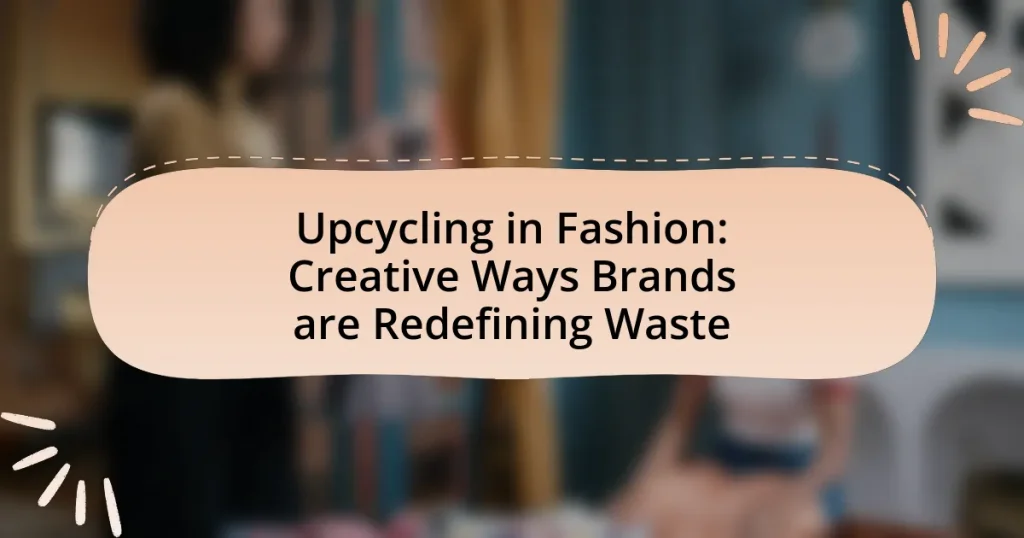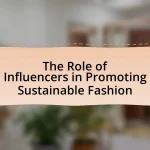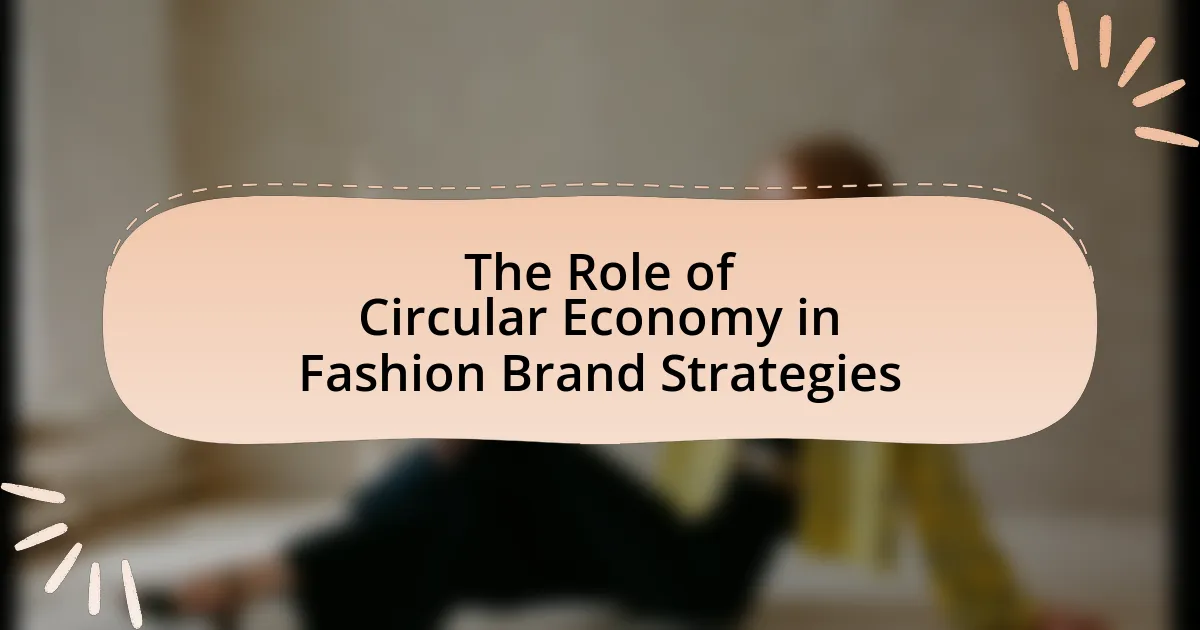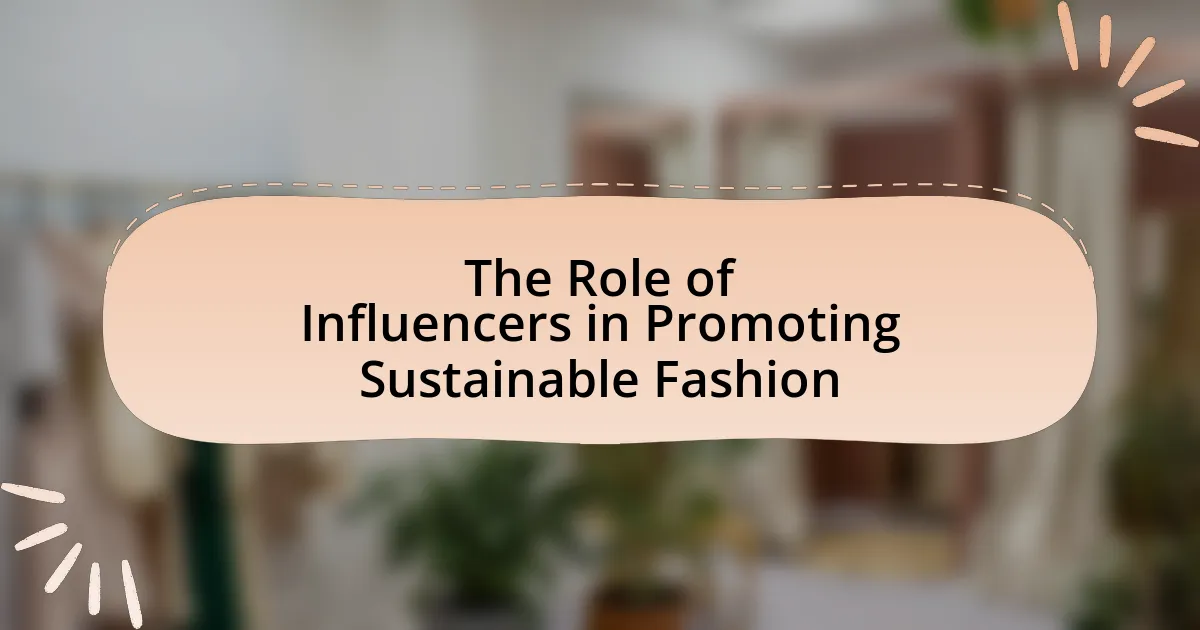Upcycling in fashion refers to the process of transforming discarded materials into new, higher-quality items, promoting sustainability and creativity within the industry. This article explores the differences between upcycling and recycling, detailing the processes involved in upcycling garments, the sustainability benefits, and the key principles that guide this practice. It also examines consumer trends driving the demand for upcycled products, the challenges brands face in implementing upcycling, and the financial implications of adopting such practices. Additionally, the article highlights how consumers can engage with upcycled fashion and the role of thrift stores in supporting this movement.
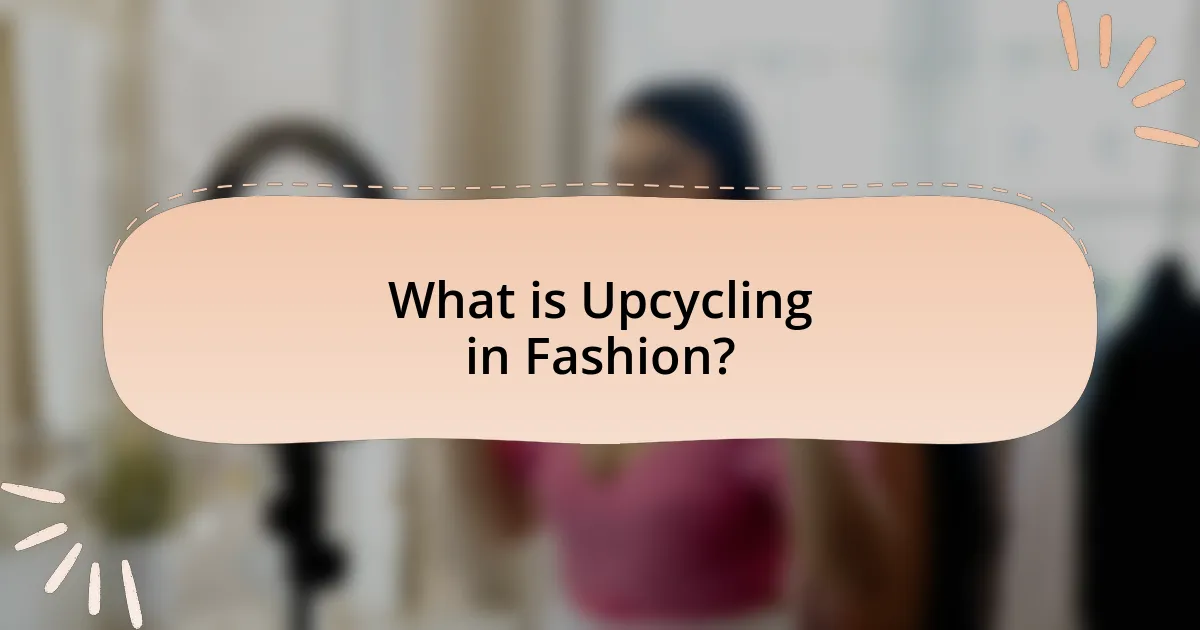
What is Upcycling in Fashion?
Upcycling in fashion is the process of transforming discarded materials or products into new, higher-quality items. This practice not only reduces waste but also encourages creativity and sustainability within the fashion industry. For instance, brands like Reformation and Patagonia utilize upcycling techniques to create unique clothing from surplus fabrics and old garments, thereby minimizing environmental impact and promoting a circular economy.
How does upcycling differ from recycling in the fashion industry?
Upcycling in the fashion industry involves transforming waste materials or unwanted products into new, higher-value items, while recycling refers to breaking down materials to create new raw materials. Upcycling enhances the original item’s value through creativity and design, often resulting in unique fashion pieces, whereas recycling focuses on material recovery and reprocessing, which can lead to a loss of the original item’s identity. For example, upcycled fashion brands like Reformation and Patagonia create new garments from discarded textiles, showcasing the potential for innovation and sustainability in fashion.
What processes are involved in upcycling garments?
Upcycling garments involves several key processes: collection, sorting, design modification, and production. Initially, garments are collected from various sources, such as donations or unsold inventory. Next, the collected items are sorted based on their condition and potential for transformation. Following sorting, designers modify the original garments by altering their structure, adding new elements, or combining multiple pieces to create unique products. Finally, the modified garments undergo production, which may include sewing, dyeing, or embellishing to enhance their appeal. This process not only reduces textile waste but also promotes sustainability in the fashion industry.
Why is upcycling considered a sustainable practice?
Upcycling is considered a sustainable practice because it transforms waste materials into new products, thereby reducing the demand for new resources and minimizing landfill waste. This process conserves energy and raw materials, as it often requires less energy than producing new items from virgin materials. For instance, a study by the Ellen MacArthur Foundation highlights that upcycling can significantly lower carbon emissions associated with production, as it utilizes existing materials rather than extracting and processing new ones. By extending the lifecycle of materials, upcycling contributes to a circular economy, promoting sustainability in fashion and other industries.
What are the key principles of upcycling in fashion?
The key principles of upcycling in fashion include creativity, sustainability, and resourcefulness. Creativity involves transforming discarded materials into new, valuable products, allowing designers to innovate while reducing waste. Sustainability emphasizes minimizing environmental impact by repurposing existing textiles instead of relying on new resources, which contributes to a circular economy. Resourcefulness highlights the importance of utilizing available materials effectively, often leading to unique and one-of-a-kind fashion items. These principles collectively aim to reduce landfill waste and promote environmentally friendly practices within the fashion industry.
How do creativity and innovation play a role in upcycling?
Creativity and innovation are essential in upcycling as they enable the transformation of waste materials into new, valuable products. This process involves reimagining discarded items, allowing designers to create unique fashion pieces that challenge conventional production methods. For instance, brands like Reformation and Patagonia utilize innovative techniques to repurpose textiles, reducing environmental impact while appealing to eco-conscious consumers. The integration of creativity fosters a culture of sustainability, encouraging the fashion industry to rethink resource use and waste management, ultimately leading to a more circular economy.
What materials are commonly used in upcycled fashion?
Common materials used in upcycled fashion include discarded textiles, vintage clothing, and surplus fabrics. These materials are repurposed to create new garments, reducing waste and promoting sustainability. For instance, according to a report by the Ellen MacArthur Foundation, the fashion industry generates over 92 million tons of waste annually, highlighting the importance of utilizing existing materials to mitigate environmental impact.
Why is upcycling gaining popularity among fashion brands?
Upcycling is gaining popularity among fashion brands due to increasing consumer demand for sustainable practices and environmental consciousness. As awareness of the fashion industry’s environmental impact grows, brands are responding by incorporating upcycling into their production processes, which reduces waste and promotes resourcefulness. For instance, a report from McKinsey & Company indicates that the global fashion industry is responsible for 10% of annual carbon emissions, prompting brands to seek innovative solutions like upcycling to mitigate their ecological footprint. This shift not only aligns with consumer values but also enhances brand loyalty and market differentiation.
What consumer trends are driving the demand for upcycled products?
The demand for upcycled products is primarily driven by consumer trends emphasizing sustainability, environmental consciousness, and unique, personalized items. Consumers increasingly prioritize eco-friendly practices, with a 2021 survey indicating that 66% of global consumers are willing to pay more for sustainable brands. Additionally, the desire for individuality in fashion leads consumers to seek out one-of-a-kind upcycled products, as these items often reflect personal style and creativity. This trend is further supported by the rise of social media platforms, where consumers share their sustainable choices, amplifying the visibility and desirability of upcycled goods.
How do brands communicate their upcycling efforts to consumers?
Brands communicate their upcycling efforts to consumers through transparent marketing strategies that highlight the environmental benefits and unique stories behind their products. For instance, brands often utilize social media campaigns, storytelling on their websites, and eco-labels to showcase the materials used and the processes involved in upcycling. Research indicates that 66% of consumers are willing to pay more for sustainable brands, emphasizing the importance of clear communication regarding sustainability efforts. By sharing behind-the-scenes content, brands can effectively engage consumers and foster a sense of connection to the upcycled products, reinforcing their commitment to sustainability.
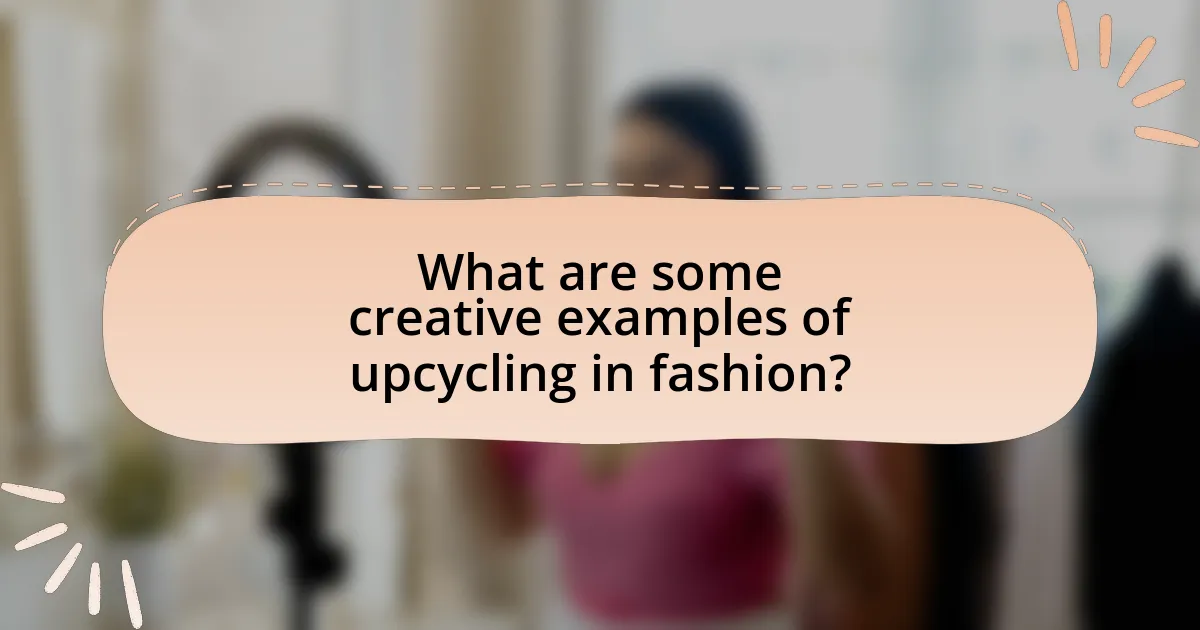
What are some creative examples of upcycling in fashion?
Creative examples of upcycling in fashion include brands transforming discarded materials into new garments, such as using old denim to create stylish jackets and bags. For instance, the brand Re/Done specializes in reconstructing vintage Levi’s jeans into modern fits, effectively reducing textile waste while offering unique pieces. Another example is the fashion label Elvis & Kresse, which repurposes decommissioned fire hoses into luxury handbags, showcasing how waste can be turned into high-value products. These practices not only promote sustainability but also highlight the innovative potential of upcycling in the fashion industry.
How are brands transforming waste into fashion statements?
Brands are transforming waste into fashion statements by utilizing discarded materials to create innovative and stylish clothing and accessories. For instance, companies like Stella McCartney and Adidas have pioneered the use of recycled plastics and textiles, turning ocean waste into high-performance sportswear. This approach not only reduces landfill contributions but also appeals to environmentally conscious consumers, as evidenced by a 2021 report from McKinsey & Company, which highlighted that 67% of consumers consider sustainability when making a purchase. By integrating waste into their designs, brands are redefining the concept of luxury and fashion, making sustainability a core aspect of their identity.
What notable collaborations have emerged in the upcycling space?
Notable collaborations in the upcycling space include the partnership between Adidas and Parley for the Oceans, which focuses on creating footwear and apparel from recycled ocean plastic. This collaboration has resulted in millions of pairs of shoes made from upcycled materials, significantly reducing plastic waste. Another example is the collaboration between Stella McCartney and the luxury brand Kering, which emphasizes sustainable practices and the use of upcycled textiles in high-fashion collections. These partnerships highlight the growing trend of integrating sustainability into fashion through innovative upcycling initiatives.
How do upcycled collections reflect current fashion trends?
Upcycled collections reflect current fashion trends by emphasizing sustainability and individuality. As consumers increasingly prioritize eco-friendly practices, brands are responding by creating unique pieces from discarded materials, aligning with the growing demand for responsible fashion. For instance, a report by McKinsey & Company highlights that 67% of consumers consider the use of sustainable materials important when making a purchase. This shift towards upcycling not only reduces waste but also fosters a sense of personal expression, as each upcycled item is often one-of-a-kind, catering to the trend of personalized fashion.
What challenges do brands face when implementing upcycling?
Brands face several challenges when implementing upcycling, primarily related to sourcing materials, consumer perception, and production processes. Sourcing high-quality, suitable waste materials can be difficult, as brands must ensure that the materials are not only available but also meet their quality standards. Additionally, consumer perception poses a challenge; many consumers may associate upcycled products with lower quality or may not understand the value of upcycled goods, which can hinder sales. Furthermore, the production processes for upcycled items often require specialized skills and techniques, leading to increased labor costs and complexity in manufacturing. These challenges can impede the successful integration of upcycling into a brand’s business model.
How can brands overcome sourcing issues for upcycled materials?
Brands can overcome sourcing issues for upcycled materials by establishing strong partnerships with suppliers and leveraging technology for efficient material tracking. By collaborating with waste management companies and local businesses, brands can secure a consistent supply of upcycled materials. Additionally, utilizing platforms that connect brands with surplus materials can streamline the sourcing process. For instance, companies like Reclaimed Wood Exchange facilitate access to reclaimed materials, demonstrating the effectiveness of such partnerships. Furthermore, implementing data analytics can help brands identify trends in material availability, allowing for proactive sourcing strategies.
What are the financial implications of adopting upcycling practices?
Adopting upcycling practices can lead to significant financial benefits for fashion brands, including cost savings and increased revenue. By utilizing existing materials, brands reduce raw material costs, which can account for up to 60% of production expenses. Additionally, upcycled products often command higher price points due to their unique nature and sustainability appeal, potentially increasing profit margins. A study by the Ellen MacArthur Foundation highlights that the circular economy, which includes upcycling, could generate $4.5 trillion in economic benefits by 2030, demonstrating the substantial financial potential of these practices in the fashion industry.
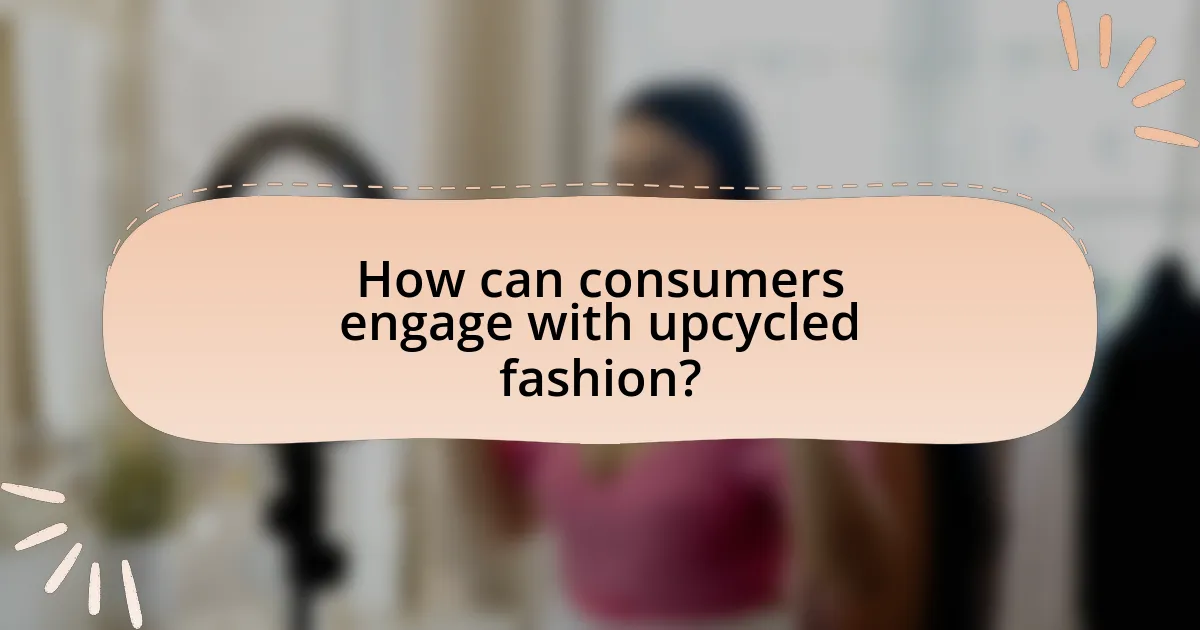
How can consumers engage with upcycled fashion?
Consumers can engage with upcycled fashion by purchasing items made from repurposed materials, participating in upcycling workshops, and supporting brands that prioritize sustainability. By buying upcycled clothing, consumers contribute to reducing textile waste, as the fashion industry generates over 92 million tons of waste annually. Workshops allow consumers to learn skills to transform old garments into new pieces, fostering creativity and sustainability. Supporting brands that focus on upcycling not only promotes eco-friendly practices but also encourages the growth of a circular economy in fashion.
What are the benefits of choosing upcycled clothing?
Choosing upcycled clothing offers significant environmental benefits by reducing waste and conserving resources. Upcycling transforms discarded materials into new products, thereby minimizing landfill contributions and lowering the demand for virgin materials. According to a report by the Ellen MacArthur Foundation, the fashion industry is responsible for 92 million tons of waste annually, highlighting the importance of sustainable practices like upcycling. Additionally, upcycled clothing often requires less water and energy compared to traditional manufacturing processes, further decreasing the ecological footprint associated with fashion production.
How does purchasing upcycled fashion contribute to sustainability?
Purchasing upcycled fashion contributes to sustainability by reducing waste and minimizing the demand for new resources. Upcycling transforms discarded materials into new products, thereby diverting textiles from landfills and decreasing the environmental impact associated with textile production, which is responsible for significant water consumption and pollution. According to the Ellen MacArthur Foundation, the fashion industry is the second-largest consumer of water and contributes to 10% of global carbon emissions; thus, upcycling helps mitigate these issues by extending the lifecycle of materials.
What should consumers look for when buying upcycled products?
Consumers should look for the quality and durability of upcycled products, ensuring they are made from reliable materials that can withstand use. Additionally, they should verify the transparency of the sourcing process, confirming that the materials used are genuinely upcycled and not just repurposed waste. Certifications or labels indicating sustainable practices can also provide assurance of the product’s environmental impact. Research shows that upcycled products can reduce waste by up to 90%, making informed choices crucial for supporting sustainable fashion.
What practical tips can consumers follow to support upcycling in fashion?
Consumers can support upcycling in fashion by choosing to buy second-hand clothing and products made from upcycled materials. This practice reduces waste and encourages brands to adopt sustainable methods. Additionally, consumers can participate in clothing swaps or upcycling workshops, which promote creativity and extend the life of garments. According to a report by the Ellen MacArthur Foundation, extending the life of clothing by just nine months can reduce carbon, water, and waste footprints by around 20-30%. By actively engaging in these practices, consumers contribute to a circular economy and help shift the fashion industry towards more sustainable practices.
How can individuals incorporate upcycled items into their wardrobe?
Individuals can incorporate upcycled items into their wardrobe by actively seeking out clothing and accessories made from repurposed materials. This can include shopping at thrift stores, participating in clothing swaps, or purchasing from brands that specialize in upcycled fashion. For example, according to a report by the Ellen MacArthur Foundation, the fashion industry is responsible for significant waste, and upcycling helps mitigate this by transforming discarded textiles into new garments. By choosing upcycled items, individuals not only reduce waste but also contribute to a more sustainable fashion ecosystem.
What role do thrift stores and second-hand shops play in upcycling?
Thrift stores and second-hand shops play a crucial role in upcycling by providing a source of affordable materials for creative reuse. These retail outlets facilitate the transformation of discarded items into new products, thereby reducing waste and promoting sustainability. According to a study by the Environmental Protection Agency, reusing and recycling textiles can significantly decrease landfill contributions, with thrift stores serving as a vital link in this process by making pre-owned goods accessible to consumers and designers alike. This accessibility encourages innovative practices in fashion, where individuals and brands can creatively repurpose items, further enhancing the upcycling movement.
